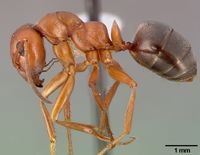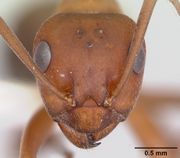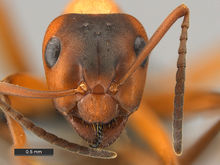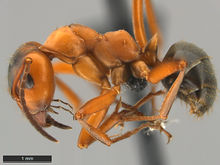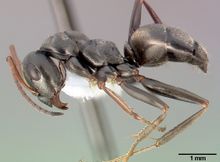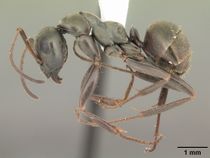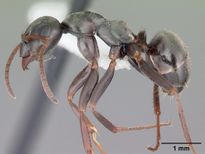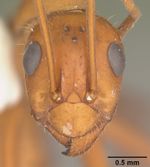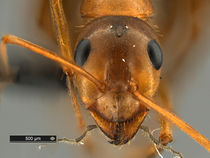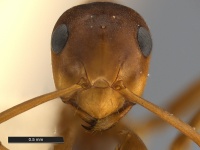Key to New England Formica
This key is modified from the 2012 book A Field Guide to the Ants of New England
.
Related pages:
1
- Top (posterior margin) of head distinctly concave; nests are large-sized mounds that can exceed 1 m in diameter (exsecta group) . . . . . 2
- Top (posterior margin) of head not distinctly concave; nests variable in size . . . . . 3
2
return to couplet #1
- Ant virtually hairless; head and mesosoma yellow-red, gaster dark . . . . . Formica exsectoides
- Ant with many erect hairs; head dark on top, red below, mesosoma red, gaster black . . . . . Formica ulkei
3
return to couplet #1
- Clypeus notched; ant bi-colored (head and mesosoma reddish-orange, gaster dark); slave-makers (sanguinea group) . . . . . 4
- Clypeus not notched; ant may be either concolorous or bi-colored; free-living or temporary social parasites . . . . . 8
4
return to couplet #3
- Few (normally < 6) very short (< 0.06mm) hairs or no erect hairs on dorsum or gaster; petiole large (broad), fan-shaped, and lacking erect hairs on its crest; a northern species found at high elevations in Massachusetts as well as throughout northern New England . . . . . Formica aserva
- At least 6 hairs > 0.06mm long on dorsum and gaster; petiole with at least a shallow notch at the crest and with one or more erect hairs on its crest . . . . . 5
5
return to couplet #4
- Erect hairs on the dorsum of the mesosoma and gaster short (0.06 – 0.14 mm), stiff, and bristle-like, usually flattened and blunt-tipped, or abruptly tapered; enslaves only ants in the fusca group . . . . . 6
- Erect hairs on the dorsum long (0.10 – 0.25 mm), evenly tapering to top; enslaves ants of many Formica groups . . . . . 7
6
return to couplet #5
- Mesosoma saddle-backed in profile; erect hairs absent on the propodeum; crest of petiole blunt in profile . . . . . Formica subintegra
- Mesosoma more curvaceous in profile; erect hairs present on the propodeum; crest of petiole sharp . . . . . Formica rubicunda
7
return to couplet #5
- Head at least as broad as it is long, and usually broader; scape shorter than length of the head; erect hairs on the gaster > 0.13 mm long and usually longer; hairs on the second gastral tergites dense and closely packed (separated by a distance less than their own length); enslaves neogagates, pallidefulva, and fusca group ants; widespread throughout New England . . . . . Formica pergandei
- The head distinctly longer than it is broad; the antennal scape is longer than the length of the head; erect hairs on the gaster < 0.13 mm long; erect hairs on the second gastral tergite separated by at least 0.1 mm (longer than the lengths of the hairs themselves); enslaves neogagates group ants; a Midwestern species rarely collected in New England . . . . . Formica creightoni
8
return to couplet #3
- Ants with distinct silvery appressed hairs (pubescence) on head, mesosoma, and gaster, and sometimes on legs; mandibles with one or two offset teeth at the base of the mandible (the part of the mandible nearest the head); concolorous (brown-to-black) or bi-colored (black head and gaster, red mesosoma; body surface usually shiny (fusca group) . . . . . 9
- Ants lacking silvery pubescence on body surfaces; mandibles without offset teeth at the base of the mandible; body color variable; body surface shiny or dull . . . . . 15
9
return to couplet #8
- The region of the cheek between the eye and the insertion of the mandible is covered with coarse, elongated punctures that are widely spaced in the posterior half of the cheek (neorufibarbis complex) . . . . . 10
- Region of the cheek between the eye and the insertion of the mandible without coarse, elongate punctures . . . . . 11
10
return to couplet #9
- A brownish-black or black ant with a hairy body; hairs are short on the mesosoma, dorsal margin of the petiole, and dorsum of the gaster . . . . . Formica hewitti
- A bi-colored ant in which the posterior half of the head and the anterior gaster are black, while the front half of the head and the mesosoma are dark red (specimens collected in bogs occasionally concolorous brown or black); hairs lacking (or < 5) on the head, promesonotum, and petiole; widespread in New England . . . . . Formica neorufibarbis
11
return to couplet #9
- Many fewer than 10 erect hairs (average = 4) on the first gastral tergite (not including the hairs on the posterior edge of the first segment); body brown-black; silvery pubescence apparent on head and mesosoma but absent or faint on gaster and legs . . . . . Formica subaenescens
- Usually more than 10 erect hairs on the first gastral tergite (not including the numerous hairs on the posterior edge of the first segment); body black or brown-black, silvery pubescence pronounced on most body parts, noticeably on the gaster (subsericea complex) . . . . . 12
12
return to couplet #11
- A brown ant; silvery pubescence dense on head, mesosoma, and all four gastral segments, but usually absent on legs . . . . . Formica argentea
- Black or brown-black ant; silvery pubescence present on legs and on first three gastral segments, but sparse to absent on fourth gastral segment . . . . . 13
13
return to couplet #12
- The length of the antennal scape is longer than length of head; pubescence on head, mesosoma, all legs, and on gastral segments 1 – 3 . . . . . Formica subsericea
- Scapes equal in length or shorter than length of head; pubescence variable . . . . . 14
14
return to couplet #13
- Promesonotum usually lacking hairs; silvery pubescence on segments 1-2, fading on segment 3; boreal, cold climates . . . . . Formica glacialis
- Promesonotum usually with erect hairs; silvery pubescence prominent on segments 1-3; extends into warmer climates . . . . . Formica podzolica
15
return to couplet #8
- Brown-to-black concolorous ants (neogagates group) . . . . . 16
- Yellow-to-red concolorous or bi-colored ants (head and mesosoma red or yellowish-red, gaster brown to black) . . . . . 17
16
return to couplet #15
- Ants of open fields; at least three white erect hairs on scape (not including hairs at the junction of the scape and the funiculus) . . . . . Formica lasioides
- Ants of forests; no (or rarely 1-2) erect hairs on scape; brown, smooth, and shiny . . . . . Formica neogagates
17
return to couplet #15
- Large, yellow-to-red, or reddish-brown, mostly concolorous, shiny ants; eyes large (eye nearly as long as cheek); top of the head strongly rounded; body long and slender (mesosoma nearly 2× as long as high) (pallidefulva group) . . . . . 18
- Bi-colored, dull-surfaced ants; eyes smaller (eye usually 30% smaller than cheek); top of head more squared-off; body more compact (mesosoma < 1.8× as long as high) (rufa and microgyna groups) . . . . . 20
18
return to couplet #17
- Large, hairy ant with a visible brush of many (> 20) long erect hairs on the propodeum; gaster densely pubescent; crest of petiole rounded (convex) on top; erect hairs on gaster dense and long . . . . . Formica dolosa
- Only a few (much less than 20) short erect hairs on the propodeum; hairs may be present or absent on mesosoma; shine of the gaster is visible between the pubescence . . . . . 19
19
return to couplet #18
- At least five hairs on the mesosoma, long, dense hairs on the gaster, and one to several long hairs on the propodeum; a shiny red or reddish-brown ant with little sculpturing on the mesosoma and gaster; found in open fields, grasslands, and heathlands Formica incerta
- No (or certainly fewer than five) hairs on the mesosoma, and short sparse hairs on the gaster; a shiny yellow-brown to dark-brown ant that is found in open- and closed-canopy forests . . . . . Formica pallidefulva
20
return to couplet #17
- The middle and hind tibiae of workers have two rows of white erect hairs on their inner surfaces; the head is distinctly longer than broad; the top (posterior) of the head rounded and evenly convex . . . . . Formica morsei
- Middle and hind tibiae of workers (and queens) with two or more rows of black or copper-colored erect hairs (rarely white); head proportions vary from broader than long to longer than broad; posterior head shape rounded to more square . . . . . 21
21
return to couplet #20
- Middle and hind tibiae of workers and queens with two rows of erect hairs on their inner surface . . . . . 22
- Middle and hind tibiae of workers and queens with hairs on all surfaces . . . . . 27
22
return to couplet #21
- Erect hairs absent on the dorsum of mesosoma and also absent on the top edge (posterior margin) of the head . . . . . 23
- Erect hairs present at least on the dorsum of the pronotum, often elsewhere on the mesosoma; erect hairs present or absent on the posterior margin of the head . . . . . 24
23
return to couplet #22
- Median lobe of the clypeus descending abruptly to the clypeal fossae; the sides of the clypeus make an angle with its upper face, giving the clypeus a pinched look. Formica cf. fossaceps - an undescribed species
- Median lobe of the clypeus descending gradually to the clypeal fossae, giving the clypeus a smooth look . . . . . Formica integra
24
return to couplet #22
- Hairs on gaster erect at base but reflexed at tip, forming little loops; crest of petiole extremely thick and rounded in profile . . . . . Formica reflexa
- Hairs on gaster not reflexed; petiole shape variable . . . . . 25
25
return to couplet #24
- Petiole, viewed from behind, appears square, with a nearly flat top and parallel sides . . . . . Formica dakotensis
- Petiole not square, with a convex top and tapered or curved sides . . . . . 26
26
return to couplet #25
- Erect hairs present on the corners of the head . . . . . Formica difficilis
- Erect hairs absent on the corners of the head . . . . . Formica querquetulana
27
return to couplet #21
- A few erect hairs on the compound eyes (visible at 25 – 50×) and scapes; dense, copper-colored hairs on mesosoma and gaster, overlaying dense grey to silvery pubescence; there is often a splotch of yellow color on the anterior part of the gaster . . . . . Formica knighti
- No hairs on the compound eyes; hairs on body not copper-colored; no yellow splotches on the gaster . . . . . 28
28
return to couplet #27
- The hairs on the pronotum are sharp and tapered (thinner at the top than at the bottom); queens at least as large as the largest worker; body very hairy . . . . . Formica obscuriventris
- Hairs on pronotum blunt, club-like (clavate), or spoon-like (spatulate), wider at the top than at the bottom; queens smaller than the largest worker . . . . . 29
29
return to couplet #28
- Gaster with very short and sparse pubescence that does not hide the surface sculpturing; a shiny ant with a dark-red to burgundy-colored head and mesosoma and a black gaster; workers have many erect hairs on the antennal scape but queens have at most 3-5 erect hairs on the scape . . . . . Formica nepticula
- Gaster with long and dense pubescence that hides the surface sculpturing; a dull-surfaced ant with red or yellow head and mesosoma and a brown or black gaster; both workers and queens have many blunt-tipped erect hairs on the antennal scape . . . . . 30
30
return to couplet #29
- Mandibles of queen with eight teeth; worker with many erect hairs all across the top of the head; queen with flattened/horizontal erect hairs on the upper corners of the head; erect hairs on legs whitish or pale yellow . . . . . Formica impexa
- Mandibles of queen with seven teeth; queen with upright erect hairs on the upper corners of the head; worker unknown . . . . . Formica dirksi





